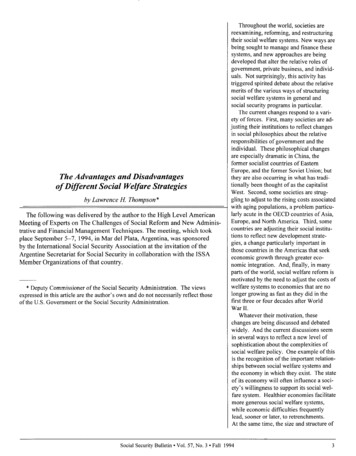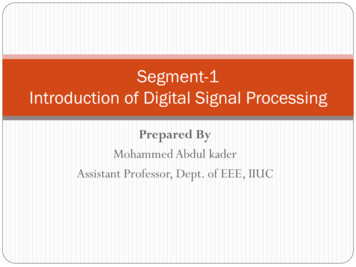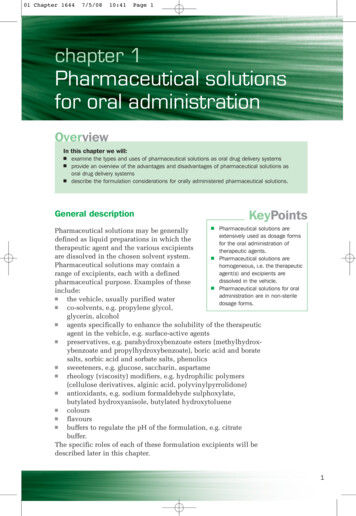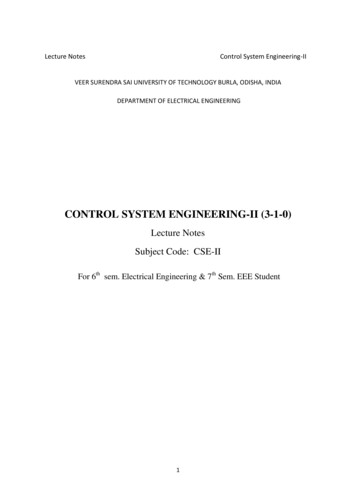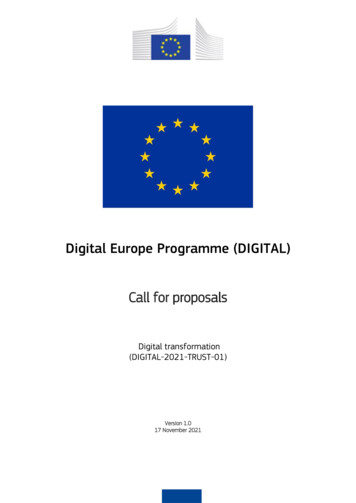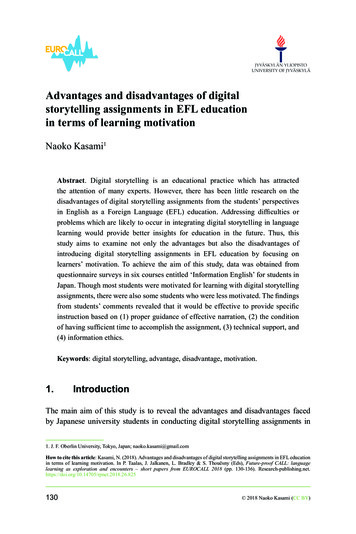
Transcription
Advantages and disadvantages of digitalstorytelling assignments in EFL educationin terms of learning motivationNaoko Kasami1Abstract. Digital storytelling is an educational practice which has attractedthe attention of many experts. However, there has been little research on thedisadvantages of digital storytelling assignments from the students’ perspectivesin English as a Foreign Language (EFL) education. Addressing difficulties orproblems which are likely to occur in integrating digital storytelling in languagelearning would provide better insights for education in the future. Thus, thisstudy aims to examine not only the advantages but also the disadvantages ofintroducing digital storytelling assignments in EFL education by focusing onlearners’ motivation. To achieve the aim of this study, data was obtained fromquestionnaire surveys in six courses entitled ‘Information English’ for students inJapan. Though most students were motivated for learning with digital storytellingassignments, there were also some students who were less motivated. The findingsfrom students’ comments revealed that it would be effective to provide specificinstruction based on (1) proper guidance of effective narration, (2) the conditionof having sufficient time to accomplish the assignment, (3) technical support, and(4) information ethics.Keywords: digital storytelling, advantage, disadvantage, motivation.1.IntroductionThe main aim of this study is to reveal the advantages and disadvantages facedby Japanese university students in conducting digital storytelling assignments in1. J. F. Oberlin University, Tokyo, Japan; naoko.kasami@gmail.comHow to cite this article: Kasami, N. (2018). Advantages and disadvantages of digital storytelling assignments in EFL educationin terms of learning motivation. In P. Taalas, J. Jalkanen, L. Bradley & S. Thouësny (Eds), Future-proof CALL: languagelearning as exploration and encounters – short papers from EUROCALL 2018 (pp. 130-136). pnet.2018.26.825130 2018 Naoko Kasami (CC BY)
Advantages and disadvantages of digital storytelling assignments in EFL.EFL classrooms. Information and Communication Technologies (ICT) constitutean integral part of the teaching and learning environment and become moreimportant in language education (Penner & Grodek, 2014). Digital storytelling isan educational practice which has received attention in the literature. For instance,Robin (2006) states that “Digital Storytelling has become a powerful instructionaltool for both students and educators” (p. 709) and the StoryCenter website2 indicatesthat “digital storytelling can be an incredibly powerful way to foster creativity,engage [the] community, transform perspectives, and encourage reflect[ion] uponlearning and life processes” (para 1). Language learning can also be promoted withdigital storytelling, as Ohler (2013) pointed out that digital storytelling has greatpotential to help students learn language because of the interplay between writing,speaking, and listening.Despite the considerable amount of research that has been conducted ondigital storytelling, the focus has often been on their advantages. It was statedthat while some disadvantages were noted, overall, the advantages of digitalstorytelling outweighed the disadvantages (De Jager et al., 2017). However, itis this researcher’s belief that focusing on the disadvantages or difficulties ofdigital storytelling would be effective for overcoming the shortcomings andutilizing the advantages. Hence, the following specific research questions wereaddressed: What are the advantages of digital storytelling assignments in EFL coursesin terms of student motivation for learning? What are the disadvantages of digital storytelling assignments in EFLcourses in terms of student motivation for learning? What factors are necessary to overcome difficulties?2.Background and method2.1.BackgroundThe author has focused on the effectiveness and advantages of digital storytellingin a previous study (Kasami, 2017), where results show that most students2. ntro-to-ds131
Naoko Kasami(77.77%) were motivated for learning with digital storytelling assignments morethan with the traditional storytelling assignments. However, there were still somestudents (7.94%) who were less motivated (Kasami, 2017). Consequently, it wasnecessary to find out and overcome these difficulties in order to improve teachingand learning.2.2.MethodThe courses and data collection in this paper were conducted as outlined in thisresearcher’s previous study (Kasami, 2017), with new data from the coursesheld in the following academic terms. This study focuses on the practices of sixcourses entitled ‘Information English’ for students at the Faculty of Informationand Communications in Japan. The courses, with 153 students in total, were heldduring the fall term of 2015 and spring term of 2016. This study comprised 96students who had answered all (pre, midterm, and post) questionnaires and hadtaken three tests under the same conditions as those in the previous research.The open-ended questions were presented to ask ‘good’ and ‘bad’ points aboutthe digital storytelling assignment in the post questionnaire. Sixty-six out of 96students commented. Out of these responses, two comments were not related tomotivation and 64 comments were chosen which related to motivation for learning.From the comments, advantages and disadvantages were analyzed and factors forovercoming difficulties were explored.3.Results and discussion3.1.AdvantagesStudents were asked “Please write down good points of the digital storytellingassignment if there are any”. Positive comments were given by 48 students. Fromall of the comments, the author and another collaborator collected keywords.Keywords which had a frequency of more than two are shown in Figure 1.Some students’ comments had multiple keywords. From the many students whoresponded very positively towards the digital storytelling, the principal keywordsincluded ‘English’, ‘Movie / PC’, ‘Create’ and ‘Interesting / Fun’.When asked about the advantages of introducing digital storytelling in EFLcourses, most students referred to their attractive features. The following responsesare some examples of positive comments (Figure 2).132
Advantages and disadvantages of digital storytelling assignments in EFL.Figure 1. Keywords of advantagesFigure 2. Examples of positive comments3.2.DisadvantagesStudents were asked “Please write down the bad points of the digital storytellingassignment which should be improved if there are any”. Negative comments weregiven by 16 students. All of the comments were classified into the four categories;(1) Narration Difficulties (n 6), (2) Shortage of Time (n 5), (3) PC Problems(n 3), and (4) Copyright (n 2).133
Naoko KasamiWhen asked about the disadvantages of introducing digital storytelling in EFLcourses, 16 negative comments were received from the students, including somefrom those who were satisfied with the digital storytelling assignment. Thefollowing responses are some examples of negative comments (Figure 3).Figure 3. Examples of negative comments3.3.Factors for overcoming difficultiesThe following are some potential solutions to the problems encountered.First, the most frequently occurring problems related to recording narration witha microphone. These problems were solved by allowing students to use additionalheadphones or setting the device options. Another problem was the volumeof narration being set too low and some narrations were not clearly audible. Tosolve this problem, it was necessary to recommend that students rehearsed andchecked the volume of their recorded narration at the beginning of each step. It wasalso effective for considering the balance of narration and selecting appropriatebackground music.Second, five students indicated that there was not sufficient time to create theirdigital stories. It was inferred that the students who experienced difficulties with134
Advantages and disadvantages of digital storytelling assignments in EFL.writing scenarios in English and who spent longer periods writing fell behindschedule. Consequently, the time period for creating the digital story becamelimited. In order to improve this problem, it was necessary to emphasize timemanagement skills to meet their deadlines. It was also recommended that theschedule should be less tight. If there was sufficient time, effective peer-feedbackcould be provided as well as teacher support.Third, three students commented that they were demotivated because of theirlower computer literacy skills and experienced difficulty with using computers.The most technically challenging parts should be explained adequately, especiallyadding music to the movie file, adjusting the timing of the music, and rerecordingnarrations.Fourth, the copyright issues are very important in this kind of assignment. Sincethis format is digital, it is very important to consider how to deal with digitalinformation, so basic information ethics become very significant. Many studentswould like to include their favourite music, anime, and characters, however, inmany cases, this is not allowed as it infringes various copyrights and portraitrights. Therefore, it was necessary for students to use copyright free picturesand music. These issues should be explained in the early stages of the projectrepeatedly.4.ConclusionsThe purpose of this study was to clarify the advantages and disadvantages facedby digital storytelling assignments in EFL. The results show that most studentsexpressed positive views on digital storytelling assignments and considered moviesand ICT both interesting and useful for English learning.Regarding disadvantages, this research identified four problems. The findingssuggested that teachers should provide specific instruction based on (1) properguidance of effective narration, (2) the condition of having sufficient time toaccomplish the assignment along with suitable advice, (3) technical support withtroubleshooting tips, and (4) copyright and portrait rights which are related toinformation ethics.More comprehensive views and in-depth analyses should be conducted in futureresearch. Future studies should discuss how these improvements in instructionaffect student learning motivation for better education.135
Naoko Kasami5.AcknowledgementsI would like to thank Dr Julian Lewis for his advice on my paper.ReferencesDe Jager, A., Fogarty, A., Tewson, A., Lenette, C., & Boydell, K. M. (2017). Digital storytellingin research: a systematic review. The Qualitative Report, 22(10), 2548-2582.Kasami, N. (2017). The comparison of the impact of storytelling and digital storytellingassignments on students’ motivations for learning. In K. Borthwick, L. Bradley & S.Thouësny (Eds), CALL in a climate of change: adapting to turbulent global conditions –short papers from EUROCALL 2017 (pp. 177-183). Research-publishing.net. 09Ohler, J. B. (2013). Digital storytelling in the classroom: new media pathways to literacy,learning, and creativity (2nd ed.). https://doi.org/10.4135/9781452277479Penner, N., & Grodek, E. (2014). Integrating multimedia ICT software in language curriculum:students’ perception, use, and effectiveness. The EUROCALL Review, 22(1), 20-39. https://doi.org/10.4995/eurocall.2014.3637Robin, B. (2006). The educational uses of digital storytelling. In C. Crawford, R. Carlsen, K.McFerrin, J. Price, R. Weber & D. Willis (Eds), Proceedings of SITE 2006--Society forInformation Technology & Teacher Education International Conference (pp. 709-716).136
Published by Research-publishing.net, a not-for-profit associationContact: info@research-publishing.net 2018 by Editors (collective work) 2018 by Authors (individual work)Future-proof CALL: language learning as exploration and encounters – short papers from EUROCALL 2018Edited by Peppi Taalas, Juha Jalkanen, Linda Bradley, and Sylvie ThouësnyPublication date: 2018/12/08Rights: the whole volume is published under the Attribution-NonCommercial-NoDerivatives International (CC BYNC-ND) licence; individual articles may have a different licence. Under the CC BY-NC-ND licence, the volume isfreely available online 221) for anybody to read, download, copy, andredistribute provided that the author(s), editorial team, and publisher are properly cited. Commercial use and derivativeworks are, however, not permitted.Disclaimer: Research-publishing.net does not take any responsibility for the content of the pages written by the authorsof this book. The authors have recognised that the work described was not published before, or that it was not underconsideration for publication elsewhere. While the information in this book is believed to be true and accurate on the date ofits going to press, neither the editorial team nor the publisher can accept any legal responsibility for any errors or omissions.The publisher makes no warranty, expressed or implied, with respect to the material contained herein. While Researchpublishing.net is committed to publishing works of integrity, the words are the authors’ alone.Trademark notice: product or corporate names may be trademarks or registered trademarks, and are used only foridentification and explanation without intent to infringe.Copyrighted material: every effort has been made by the editorial team to trace copyright holders and to obtain theirpermission for the use of copyrighted material in this book. In the event of errors or omissions, please notify the publisher ofany corrections that will need to be incorporated in future editions of this book.Typeset by Research-publishing.netCover theme by 2018 Antti Myöhänen (antti.myohanen@gmail.com)Cover layout by 2018 Raphaël Savina (raphael@savina.net)Drawings by 2018 Linda Saukko-Rauta (linda@redanredan.fi)ISBN13: 978-2-490057-22-1 (Ebook, PDF, colour)ISBN13: 978-2-490057-23-8 (Ebook, EPUB, colour)ISBN13: 978-2-490057-21-4 (Paperback - Print on demand, black and white)Print on demand technology is a high-quality, innovative and ecological printing method; with which the book is never ‘outof stock’ or ‘out of print’.British Library Cataloguing-in-Publication Data.A cataloguing record for this book is available from the British Library.Legal deposit, UK: British Library.Legal deposit, France: Bibliothèque Nationale de France - Dépôt légal: Décembre 2018.
digital storytelling, as Ohler (2013) pointed out that digital storytelling has great potential to help students learn language because of the interplay between writing, speaking, and listening. Despite the considerable amount of research that has been conducted on digital storytelling, the focus has often been on their advantages. It was stated
